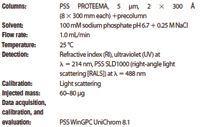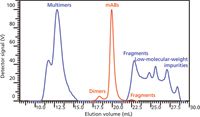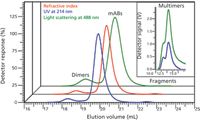Sophisticated Antibody Analysis by GPC/SEC with RALS
PSS Polymer Standards Service GmbH
Monoclonal antibodies (mABs) are increasingly growing in importance for the diagnosis and therapy of various diseases, including cancer and autoimmune and inflammatory disorders. One essential parameter to define their quality is the content of aggregates (dimers, trimers, and higher aggregates). These aggregates can be formed during processing and purification or are the result of long-term storage. As a result of aggregation, antibodies lose their pharmaceutical efficacy and can facilitate an immunology response.
Antibody fragments which lack the Fc region can be used for the treatment of diseases. They can also be the result of degradation of full length antibodies. Therefore, a GPC method, which offers the opportunity to analyse antibodies and their aggregates, as well as antibody fragments simultaneously, with superior resolution and high sensitivity is invaluable.
Experimental
GPC/SEC analysis was performed on a PSS SECcurity GPC system, equipped with a PSS SECcurity SLD1000 light scattering detector, using the following conditions:

Results
Figure 1 shows an overlay of elugrams obtained for a full length antibody and antibody fragments analysed on a single set of columns.

Figure 1: Separation range of the column combination. The red curve shows the UV signal of a full length antibody and its dimers plotted against the elution volume. The blue curve is the elugram of antibody fragments and their high level aggregates.
All three detector signals for the analysis of a monoclonal antibody are shown in Figure 2. The light scattering signal shows improved sensitivity for high aggregates compared to the other signals.

Figure 2: Sensitive analysis of antibody aggregates. The light scattering signal for the dimer is relatively high compared to that of the mABs because of molar mass dependency and provides improved sensitivity for the detection of high aggregates (inset).
Conclusion
The GPC/SEC method including UV, RI, and RALS can be used for the simultaneous determination of aggregate content of monoclonal antibodies as well as antibody fragments. The column combination covers the separation range for all three types and provides a high resolution for the determination of the dimer content. Because of its molecular weight dependency, the PSS SLD1000 RALS detector offers high sensitivity for very small quantities of high aggregates and also allows the determination of the absolute molecular weight of the antibodies. In addition, it has a unique feature for a light scattering detector as the wavelength can be altered to increase the sensitivity.

PSS Polymer Standards Service GmbH
In der Dalheimer Wiese 5, D-55120 Mainz, Germany
Tel: + 49 6131 962390 fax: + 49 6131 962390 11
E-mail: info@pss-polymer.com
Website: www.pss-polymer.com

A Novel LC–QTOF-MS DIA Method for Pesticide Quantification and Screening in Agricultural Waters
May 8th 2025Scientists from the University of Santiago de Compostela developed a liquid chromatography quadrupole time-of-flight mass spectrometry (LC–QTOF-MS) operated in data-independent acquisition (DIA) mode for pesticide quantification in agriculturally impacted waters.
Investigating 3D-Printable Stationary Phases in Liquid Chromatography
May 7th 20253D printing technology has potential in chromatography, but a major challenge is developing materials with both high porosity and robust mechanical properties. Recently, scientists compared the separation performances of eight different 3D printable stationary phases.

.png&w=3840&q=75)

.png&w=3840&q=75)



.png&w=3840&q=75)



.png&w=3840&q=75)

















